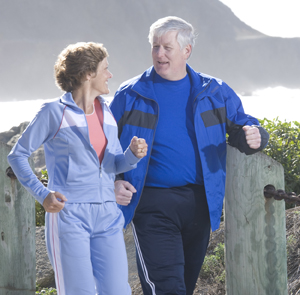Exercise for a Healthier Heart
You may wonder how you can improve the health of your heart. If you’re thinking about exercise, you’re on the right track. You don’t need to become an athlete. But you do need a certain amount of brisk exercise to help strengthen your heart. If you have been diagnosed with a heart condition, your healthcare provider may advise exercise to help your condition. To help make exercise a habit, choose safe, fun activities.
 |
| Exercise with a friend. When activity is fun, you're more likely to stick with it. |
Before you start
Check with your healthcare provider before starting an exercise program. This is especially important if you haven't been active for a while. It's also important if you have a long-term (chronic) health problem such as heart disease, diabetes, or obesity. Also check with your provider if you're at high risk for having these problems.
Why exercise?
Exercising regularly offers many healthy rewards. It can help you do all of these:
-
Improve your blood cholesterol level to help prevent further heart trouble.
-
Lower your blood pressure to help prevent a stroke or heart attack.
-
Control diabetes or reduce your risk of getting this disease.
-
Improve your heart and lung function.
-
Reach and stay at a healthy weight.
-
Make your muscles stronger so you can stay active.
-
Prevent falls and fractures by slowing the loss of bone mass (osteoporosis).
-
Manage stress better.
-
Improve your sense of self and your body image.
Exercise tips
-
Ease into your routine. Set small goals. Then build on them. Talk with your healthcare provider first before starting an exercise routine if you're not sure what your activity level should be.
-
Exercise on most days. Aim for a total of at least 150 minutes (2 hours and 30 minutes) or more of moderate-intensity aerobic activity each week. You could also do 75 minutes (1 hour and 15 minutes) or more of vigorous-intensity aerobic activity each week. Or try for a combination of both. Moderate activity means that you breathe heavier and your heart rate increases, but you can still talk. Think about doing at least 30 minutes of moderate exercise, 5 times a week. It's OK to work up to the 30-minute period over time. Examples of moderate-intensity activity are brisk walking, gardening, and water aerobics.
-
Step up your daily activity level. Along with your exercise program, try being more active the whole day. Walk instead of drive. Or park further away so that you take more steps each day. Do more household tasks or yard work. You may not be able to meet the advised amount of physical activity. But doing some moderate- or vigorous-intensity aerobic activity can help reduce your risk for heart disease. Your healthcare provider can help you figure out what is best for you.
-
Choose 1 or more activities you enjoy. Walking is one of the easiest things you can do. You can also try swimming, riding a bike, dancing, or taking an exercise class.
Call 911
Call 911 right away if any of these occur:
-
Chest pain that doesn't go away quickly with rest
-
New burning, tightness, pressure, or heaviness in your chest, neck, shoulders, back, or arms
-
Abnormal or severe shortness of breath
-
A very fast or irregular heartbeat (palpitations)
-
Fainting
When to call your healthcare provider
Call your healthcare provider if you have any of these:
-
Dizziness or lightheadedness
-
Mild shortness of breath or chest pain
-
Increased or new joint or muscle pain
Online Medical Reviewer:
Callie Tayrien RN MSN
Online Medical Reviewer:
Stacey Wojcik MBA BSN RN
Online Medical Reviewer:
Steven Kang MD
Date Last Reviewed:
7/1/2022
© 2000-2025 The StayWell Company, LLC. All rights reserved. This information is not intended as a substitute for professional medical care. Always follow your healthcare professional's instructions.